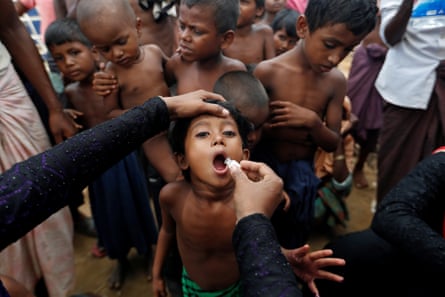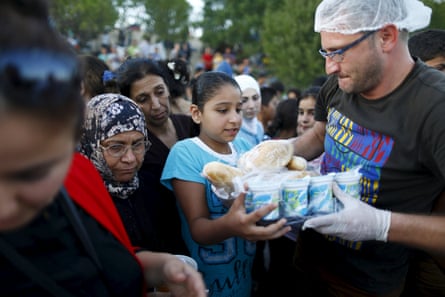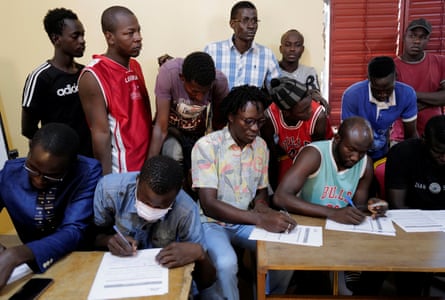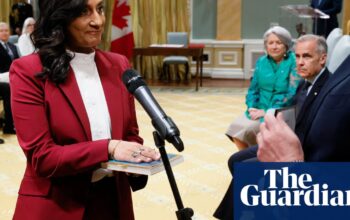Before civil war engulfed her Ethiopian home region of Tigray in 2020, Tsega Girma was a prosperous trader who sold stationery and other goods. But when hungry children displaced by the conflict started appearing in the streets, she sold everything and used the proceeds to buy them food.
After that money dried up, Tsega appealed to Tigray’s diaspora for donations. At the height of the war, her Emahoy Tsega Girma Charity Foundation provided meals to 24,000 children a day.
Today, more than a year after the conflict ended, it still feeds 5,000 children who cannot return home because of lingering insecurity.
All the food is bought locally and prepared by volunteers in the grounds of a disused library. “It is emergency work,” Tsega says. “We are doing this simply to keep them alive.”
Charities such as Tsega’s, set up by individuals to help their own communities, are the oldest form of humanitarianism. Yet they are also being viewed as the future of an overstretched and underfunded aid system that relies on international organisations and UN agencies to devise and deliver programmes.
In a recent landmark white paper on development, the UK’s Foreign Office (FCDO) said it would deliver aid in poor countries “as far as possible through local institutions and organisations”. Meanwhile, the US Agency for International Development (USAid) plans to channel at least 25% of its funding through “local partners” by 2025. By the end of the decade, USAid wants at least 50% of its programmes to be driven by local agencies.
This commitment to “localising” aid is not entirely new. In 2016, a UN conference of 9,000 delegates gathered in Istanbul to make the delivery of humanitarian aid sustainable and effective. One of its key outcomes was a pledge to allocate 25% of funds to “local and national responders” by 2020.

The idea of localising aid gained further traction during the Covid-19 pandemic, when aid agencies leaned heavily on local partners because of travel restrictions. Amy Croome, a humanitarian policy adviser specialising in localisation at Oxfam, says: “A few years ago, localisation was a crazy idea. Now it is completely mainstream.”
Today, however, just 2.1% of donor money goes to local organisations, either directly or indirectly, according to Development Initiatives, a research consultancy.
Kennedy Odede, head of Shining Hope for Communities, a grassroots organisation that works in Kenyan slums, says the humanitarian aid system is “still characterised by a colonial mindset” that largely ignores the cultural knowledge of organisations such as his.
“They believe they can just walk into a community and they’ll solve the problem if they have enough money, but that’s not how you create change,” says Odede, who grew up in Kibera, the biggest urban slum in Africa and one of the places where his NGO works.
The lack of money for local aid groups is partly a consequence of the funding crisis facing the humanitarian system. Last year, the UN received just 43% of the money it appealed for to help people in need – its biggest ever shortfall. Funds are drying up as needs expand hugely owing to conflict and climate change.
“International aid agencies are competing with local NGOs at a time when they are strapped for cash, so they are hardly going to support them,” says a senior UN humanitarian official. “They don’t want to give up their funding.”
There are also fears of corruption at small organisations that lack audited accounts and rigorous monitoring. A humanitarian adviser at the FCDO says it does not have the manpower to fund local NGOs directly, because it would require a lot of due-diligence legwork to track taxpayers’ money.
“It’s much more efficient to give the funds to an international NGO and delegate responsibility to them, rather than set up funding arrangements with multiple local NGOs,” says the adviser.

The European Union, meanwhile, has rules that bar it from giving humanitarian funds to groups based outside the bloc.
Yet local NGOs are usually much more cost-efficient, with far lower overheads than international organisations, which rely on well-paid foreign staff, says Juliet Donna Eyokia, from Community Empowerment for Rural Development, a Ugandan provider of health, education and humanitarian programmes.
A western aid worker in Addis Ababa, Ethiopia’s capital, for example, gets as much as $2,000 (£1,600) a month in addition to their salary, just to spend on housing. That money alone could pay the salaries of “four or five” local NGO workers, says Eyokia.
“Local actors deliver much more with the little they have compared to international actors,” she says. “At a time when there are multiple humanitarian crises, not just in Africa but globally, you can have a more significant impact if you don’t rely on international actors to respond.”
after newsletter promotion
This is particularly pertinent in countries such as Chad, Afghanistan and the Democratic Republic of the Congo, where aid groups designed to deal with short-term crises find themselves staying on for years, or even decades, running government services such as health and education.
“The system is simply unsustainable,” says Paul Spiegel at Johns Hopkins University. “We need UN agencies and big NGOs to take a back seat and to ensure national NGOs have enough capacity to respond.”
Eyokia argues that local NGOs are more accountable to their beneficiaries. They are also often in better positions to help their communities, she says. “International NGOs find it hard to access affected communities, whereas we are part of the communities we serve. We are there before, during and after a disaster.”
Tsega’s feeding programme in Tigray illustrates this. It continued throughout the 2020-22 war in northern Ethiopia. By contrast, UN agencies could not deliver aid for months at a time because of restrictions imposed by the Ethiopian government. Volunteer networks called emergency response rooms are playing a similar role in Sudan’s war, delivering food and medicine to people behind frontlines.

Sameena Gul, head of localisation at the global organisation HelpAge International, says the humanitarian system has grown so large “it has become a business”.
Yet needs are at an all-time high. “We have thousands of international NGOs running programmes, but what has really changed?” asks Gul. “It’s better to have local NGOs running these services.”
HelpAge International is in the process of turning regional offices into independent and self-regulating local organisations. When this process is complete, the international organisation will play a supporting role.
“Local organisations have a legitimacy and contextual knowledge that international NGOs lack,” she says. “They have a better understanding of the problems and they also know the appropriate solutions.”
Oxfam is another big agency localising much of its operations. Croome says it has reduced the number of staff in its Kenya office from 85 to fewer than 10, while transferring duties to local partners. It has also set up networks of local NGOs to help them work together more effectively.
Both Oxfam and HelpAge are among the nearly 40 international NGOs that have signed the Charter for Change, committing them to localisation.
Croome is critical of aid agencies that “subcontract” responsibilities such as delivering food to local NGOs and call it localisation.
“It doesn’t change the fundamental power imbalances,” she says. “We want local actors to set the agenda for humanitarian responses, so the whole system is less internationally dominated and [becomes] locally led.”
Croome says international NGOs such as Oxfam still have a role to play in a localised aid system. This would involve fundraising, providing technical expertise to local aid agencies, and lobbying governments for policy changes.
“International groups would not be designing humanitarian responses,” she says. “They would be there as partners supporting local actors.”
Source: theguardian.com


